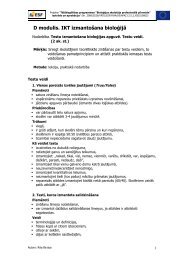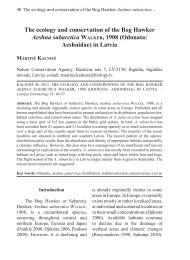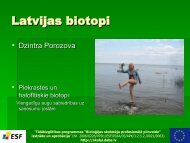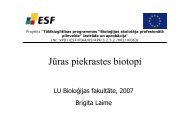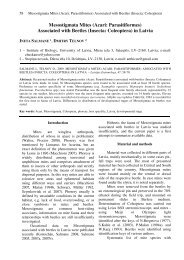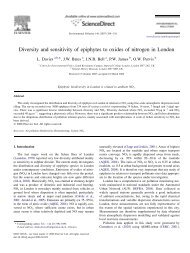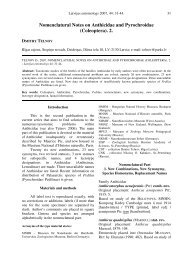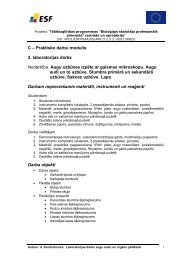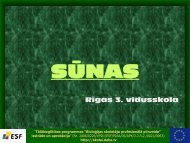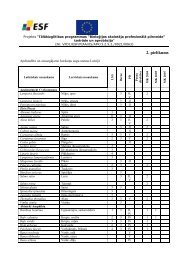Dissolved organic matter in water of Daugava river
Dissolved organic matter in water of Daugava river
Dissolved organic matter in water of Daugava river
Create successful ePaper yourself
Turn your PDF publications into a flip-book with our unique Google optimized e-Paper software.
AB<strong>in</strong>d<strong>in</strong>g <strong>of</strong> the Novel 4-tricyanov<strong>in</strong>ylarylam<strong>in</strong>e Dye to Fibrillar LysozymeK.Vus* 1 , V.Trusova 1 , G.Gorbenko 1 , T.Deligeorgiev 2 , S.Kaloyanova 2 , N.Lesev 21 Faculty <strong>of</strong> Physics and Technology, V. N. Karaz<strong>in</strong> Kharkiv National University, Kharkiv,Ukra<strong>in</strong>e;2 Faculty <strong>of</strong> Pharmacy and Chemistry, University <strong>of</strong> S<strong>of</strong>ia “St. Kliment Ohridsky”, S<strong>of</strong>ia,Bulgariae-mail: katenka.vus@mail.ruAccumulation <strong>of</strong> fibrillar prote<strong>in</strong> aggregates (amyloid fibrils) <strong>in</strong> different tissues is currentlyassociated with a variety <strong>of</strong> so called conformational diseases. The most widespreadtechniques employed <strong>in</strong> identification <strong>of</strong> amyloid fibrils are fluorescence and absorptionspectroscopy. Further progress <strong>in</strong> this research area is strongly coupled with the design andtest<strong>in</strong>g <strong>of</strong> the novel chromo- and fluorophores. The present study was aimed at evaluation <strong>of</strong>the novel 4-tricyanov<strong>in</strong>ylarylam<strong>in</strong>e dye (referred here as 3q) as possible marker for fibrillarprote<strong>in</strong> aggregates. Amyloid fibrils <strong>of</strong> lysozyme were prepared at strongly acidic pH [1] .Tricyanov<strong>in</strong>ylarylam<strong>in</strong>e probes are characterized by high ext<strong>in</strong>ction coefficients and theability to form <strong>in</strong>tramolecular charge transfer state upon excitation [2] . Fluorescent properties<strong>of</strong> these dyes are sensitive to their molecular structure and local environment. It appeared that3q has very low quantum yields <strong>in</strong> buffer solution and there was no fluorescence <strong>in</strong>crease <strong>in</strong>the presence <strong>of</strong> amyloid fibrils. For this reason, we tested this dye as possible analog <strong>of</strong> thetraditional amyloid marker Congo Red, non-fluoresc<strong>in</strong>g dye whose differential absorptionspectra are used for selective detection <strong>of</strong> amyloid fibrils. As seen <strong>in</strong> Fig. 1A, <strong>in</strong>creas<strong>in</strong>g theconcentration <strong>of</strong> fibrillar lysozyme leads to progressive decrease <strong>of</strong> 3q absorption, with clearisosbestic po<strong>in</strong>t. Quantitative characteristics <strong>of</strong> the dye b<strong>in</strong>d<strong>in</strong>g to prote<strong>in</strong> aggregates ( Ka–association constant, n – b<strong>in</strong>d<strong>in</strong>g stoichiometry, α – the difference <strong>of</strong> ext<strong>in</strong>ction coefficients <strong>in</strong>the bound and free states) were estimated by analys<strong>in</strong>g the isotherm <strong>of</strong> 3q b<strong>in</strong>d<strong>in</strong>g tolysozyme fibrils <strong>in</strong> terms <strong>of</strong> Langmuir adsorption model (Fig. 1B). The recovered parametersare close to those reported for exist<strong>in</strong>g amyloid-sensitive chromophores.0.10NC3q0.05NCCH 2CH 2N(CH 3) 3Lysozyme amyloidCNClO4concentration, M0.00244563-0.057892104-0.10116350 400 450 500 550 600 650H 2CNWavelength, nmABFig.1. Differential absorption spectra <strong>of</strong> 3q (A) and the isotherm <strong>of</strong> 3q b<strong>in</strong>d<strong>in</strong>g to fibrillarlysozyme (B).To conclude, spectral behavior <strong>of</strong> 3q as one representative <strong>of</strong> tricyanov<strong>in</strong>ylarylam<strong>in</strong>e dyesallowed us to recommend these compounds for test<strong>in</strong>g as possible amyloid markers similar toCongo Red.This work was supported by the grants from European Social Fund (project number2009/0205/1DP/1.1.1.2.0/09/APIA/VIAA/152) and Fundamental Research State Fund <strong>of</strong>Ukra<strong>in</strong>e (project number F.41.4/014).- 34 -A 5020.100.080.060.040.020.00K a= 0.13 M -1n = 0.5 mol/mol = -0.0028 M -1 cm -10 20 40 60 80 100 120Prote<strong>in</strong> concentration,



